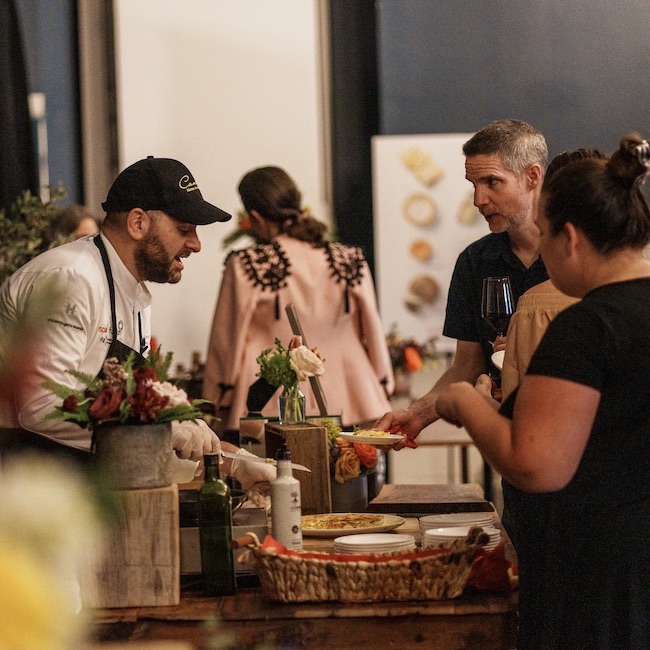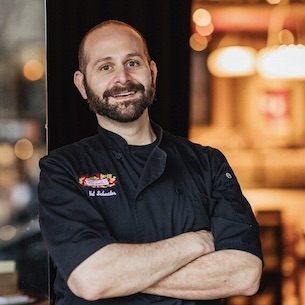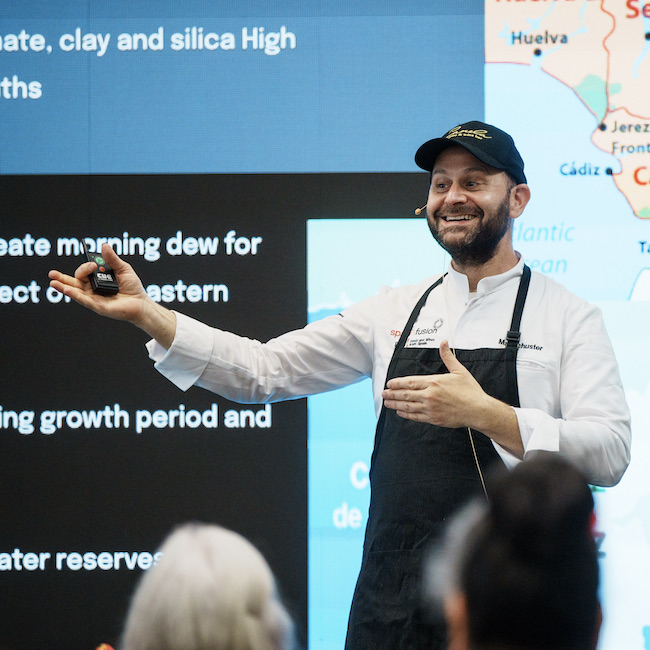.png.transform/rendition-xs/image_image%20(1).png)
Chef Mat Schuster: "History is Essential to Understand Spanish Cuisine"
Schuster shares his views on Spanish Gastronomy and the story of his restaurant, Canela
by Esperanza Peláez
Mat Schuster, chef and president of the Golden Gate Restaurant Association and member of the international Certified Restaurants of Spain network (Restaurants from Spain (foodswinesfromspain.com), discovered Spanish cuisine when he was already a seasoned chef. His restaurant, Canela Bistro&Wine Bar (https://canelasf.com/our-story/ in San Francisco, is the result of a twofold love affair; one he has had for 18 years with his partner, who is from Córdoba, and one that sprang from his mother-in-law’s cooking, who was the first to introduce him to traditional recipes.
At Spain Fusión Texas Food and Wines from Spain, Schuster was responsible for introducing Texans to the world of sherry vinegars, flawlessly conveying the theory behind them and, on the practical side, using them to express his culinary personality via creations as simple and memorable as his PX PDO Jerez reserve vinegar, soda and berry mocktail: A version of posca, an Ancient Roman beverage and a 21st-century twist on traditional alcohol-free drinks enjoyed by harvesters in the fields. Schuster says that internships in Spanish restaurants, when the creative renovation of regional cuisine was in its heyday, helped him understand that authenticity is compatible with change. His tortilla de patatas was worthy of a prize, and for the cocktail parties of this itinerant event – promoted by ICEX in the Texan cities of Houston, Dallas, San Antonio and Austin – he made it without onion, but he did make a few with a hint of pickled jalapeño or a few pieces of chorizo, and for that he was given a standing ovation by the attendees. Long live fusion!
How did the idea of Canela come about?
“It’s a personal story. My partner is from Córdoba and we’ve been together for 18 years. When our relationship began, I starting travelling around Spain and would also go to family gatherings. Her mother taught me some traditional dishes, simple ones she made at home; I became hooked on Spanish cuisine. When I contemplated opening a Spanish restaurant, it was obvious that I had to acquire more in-depth knowledge because, in the United States, culinary training is based exclusively on the French school of cooking. Spanish cuisine was touched on, at most, for a couple of days. I travelled and did internships in Spain, although very hesitantly as I was afraid of not doing things exactly the way they were supposed to be done. But I happened to come to Spain at a time when avant-garde cuisine was being creative with traditional recipes, and that helped me a lot because I felt that I could also adapt those dishes in my own personal way.”

Did that make you feel free?
“In a way. It seems that fusion is, I don’t know, something dreadful, lacking in authenticity, but if you think about it, fusion really means cooking. Influences, ingredients and people have been mingling and travelling for thousands of years. In addition, adapting recipes was the only way to bring these dishes to a public that is not familiar with or engaged with this culinary culture, no matter how much they might want to understand it.”
Did you have to adapt the recipes?
“Yes, but not intentionally. It was more like a process of trial-and-error. For example, I love morcilla sausage – black pudding – made with onions, so when we opened the restaurant, I put it on the menu. But of course, in the United States, the idea of eating pig’s blood is somewhat shocking. It was hard coming to terms with that and we finally withdrew the dish, however, it turns out that years later we’ve been able to include it again and it’s accepted. Sometimes you have to know how to wait for the right moment to do things. Wait for people to be willing or even for the time to be right.”
Do you think you have to adapt recipes for people to have a better understanding of them?
“I think it’s a complex process. For example, at Canela we didn’t want to offer stereotypical dishes like paella, tapas and sangria. We wanted to do something different and more daring, seek something more authentic. We offered a lot more fish at the start because, for me, Galicia was a key place in my training and I fell in love with the land and its produce. But, in the end, we also included paella, tortilla, croquettes and sangria. Why not? Our sangria is a top-quality one. At our restaurant we have over seventy different Spanish wines. We sell only carefully chosen Spanish wine. Our sangria is made with good wine, we cut back on the sugar, use high-quality fruit that pairs well with the nuances of the wine, and we even dehydrate the fruit to decorate it. Sangria has become our house cocktail, and it’s very popular.”
I’m interested in what you do with morcilla sausage. How do you introduce lesser known dishes or ones that are less accepted?
“The first thing you need to do is really think about the name of the dish and how to present it to diners who aren’t familiar with our culture. Huevos rotos in Spain are very popular, but in English the literal translation is ‘broken eggs’, which sounds awful because the word ‘broken’ has a negative connotation when it comes to gastronomy. What did we do? We pondered the aspects of the dish that diners would understand. In the end, we highlighted the fact that it was a ‘runny’ fried egg that’s then combined with potatoes and other ingredients like morcilla sausage. That way we were able to get diners to understand what they were about to eat. Training your waiters is also very important in this respect. In San Francisco I can get waiters with plenty experience and an excellent CV, but the percentage of those who are familiar with Spanish cuisine is about one in a hundred. Another key thing for me is that when a diner doesn’t like a dish, it’s taken away and they’re not charged for it. In the end, a dish that a diner really likes, plus a good experience, will make them forget a previous unpleasant experience and helps to build customer loyalty.”

Is the concept of tapas well known outside Spain?
“The concept of tapas is quite tricky to convey. At Canela, we understand it and explain that it’s akin to the spirit of Spain; a festive way of eating and sharing, rather than something literal where you put a number of small plates on the table for diners to share. That’s hard to understand here, and if you add to the fact that the word ‘tapa’ is doled out for any type of cuisine and sometimes doesn’t even correspond to quality food, the result means that, more often than not, it doesn’t work. In our case, we work more with dishes rather than tapas as they are something tourists who travel to Spain also learn about and try. Those huge platters of fish, seafood or meat that are served in Galicia or Castile are Spanish food as well,” he laughs.
What’s your relationship with Spanish ingredients and products like?
“They’re the bedrock of Spanish cuisine. For me, at least, it’s impossible to understand this cuisine without authentic quality products. When we first started the restaurant, it was much harder for us to find good Spanish foodstuffs. Today, everything is more available. For example, we serve a fantastic Galician cheese, Arzúa-Ulloa, from Lugo, which is my favourite Spanish cheese. I think we’re the only restaurant in San Francisco where you can try it. In the beginning, we had to go to great lengths to find it. Now, you can practically get everything without any hassle.”
Has being awarded the Restaurants from Spain seal helped you in that regard?
“We’ve been certified for a year now. Of course, it’s very helpful to us, but it’s also a demanding certification; you have to work hard to get it, and the work you do forces you to improve. It also enables you to network with other restaurateurs and Spanish producers. In addition, you get advice, and it’s given me the chance to come to an event like Spain Fusión that’s enjoyable and where I can learn a lot from the relationship with the general public and from interacting with the team of chefs, producers and experts. It’s an honour for me to be here.”

You’re in charge of presenting sherry vinegars, and you make very personal and creative use of them.
“I’d like to stress – because for me it’s very important – that respecting a culture doesn’t mean restricting your own creativity or the possibility of connecting with diners, quite the opposite, in fact. If I’m given a product like sherry vinegar, of course I’ll use a particular type in a gazpacho or in a fruit salad, or in a pickle, but I also thought it would be a good idea to make a mocktail with fruit and soda, and it works beautifully.”
At the cocktail party you made a tortilla de patatas, which was fantastic, by the way.
“I learned how to make tortilla de patatas from my mother-in-law. It’s a traditional dish that we make at the restaurant with onion – I would even go so far as to say with a lot of onion – and we also sprinkle chives over the top. Half of Spain would probably be scandalized by that, but my in-laws are from Córdoba and I was taught to make a tortilla with onion. And moreover, from what I’ve seen, diners at Canela like it.”
At the fiesta, you made the classic version without onion and to another you added jalapeños or chorizo...
“Please don’t mention this in Spain, they’ll kill me. But they’d snatch the one with chorizo from my hands,” he laughs.
Do you think the United States is a market that’s interested in Spanish cuisine and its foodstuffs?
“Like everywhere else, gastronomic culture is improving here, and this is a market that’s more open than others to new things. Spanish cuisine can only go from strength to strength if the foodstuffs are high quality; it’s important to be determined when it comes to this. I believe that events like Spain Fusión are really necessary because, in addition to discovering wonderful foodstuffs, the story and the explanation are essential for understanding Spanish cuisine.”

